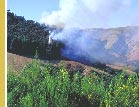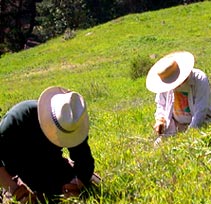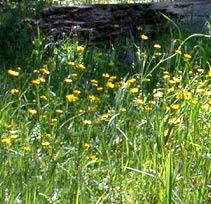
![]()
CLIENT: East Bay Regional Park District, Alameda-Contra Costa County Weed
Management Area, East Bay Municipal Utility District
PARTNERS: Danielson Consulting
 The
East Bay Regional Park District is challenged every summer to balance wildland
fire safety with natural resource protection and enhancement. A rich band
of open lands containing native forests, coastal scrub, and grasslands
border on the hill communities of Oakland, Berkeley, El Cerrito, and Kensington.
The grasslands and forests support a diversity of native plants and wildlife
but also potentially threaten neighboring cities with wildfire danger.
Goat grazing is commonly used by agencies to substantially reduce wildland
vegetation during the summer months, but this often results in bare earth
and increased infestations of exotic weeds.
The
East Bay Regional Park District is challenged every summer to balance wildland
fire safety with natural resource protection and enhancement. A rich band
of open lands containing native forests, coastal scrub, and grasslands
border on the hill communities of Oakland, Berkeley, El Cerrito, and Kensington.
The grasslands and forests support a diversity of native plants and wildlife
but also potentially threaten neighboring cities with wildfire danger.
Goat grazing is commonly used by agencies to substantially reduce wildland
vegetation during the summer months, but this often results in bare earth
and increased infestations of exotic weeds.
Removing exotic weeds and encouraging a diverse native flora reduces fire risk.
 |
 |
In February of 2002, Shelterbelt was hired by the Park District and Alameda-Contra Costa Weed Management Area to design and test a new, more sensitive wildland management regime along Tilden Park’s urban interface. For 3 years Shelterbelt managed 21-acres of the fuelbreak with selective, timed mowing regimes and hand pulling to demonstrate that fire safety can be achieved while also enhancing native plant diversity and reducing exotic weeds along the urban interface. Each year the work took place over 8 months, from January to August. Training of workers in plant identification and continuous field observation were central to the strategy. No herbicides, fire or grazing were used for the 3 years to reduce fuel loads. No planting, irrigation or other-than-natural seed dispersal was used to encourage the native flora. Each year the fuelbreak was maintained to the satisfaction of the Park District fire department and invasive plants were reduced substantially in the project site. Professional monitoring revealed substantial increases in native cover along transects, and overall native cover was estimated to have been increased an average of 5 percent a year, or from 10 percent to 25 percent in three years.
Headquarters: 22400 Skyline Boulevard #18, La Honda, CA 94020 Tel: 608.208.8074
East Bay: 510.841.0911
Email: [email protected]